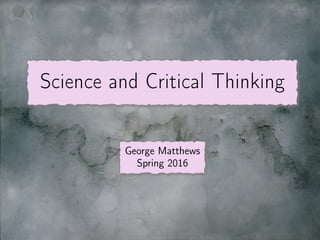01 critical-thinking
- 1. Science and Critical Thinking George Matthews Spring 2016
- 2. Why do you believe what you believe?
- 3. Why do you believe what you believe? it°Øs obvious indoctrination common sense authority prior exposure motivation evidence experience proof explanatory value ?ts with other beliefs
- 4. Why should you believe something? it°Øs obvious indoctrination common sense authority prior exposure motivation evidence experience proof explanatory value ?ts with other beliefs
- 5. the uses of reason
- 6. the uses of reason
- 7. the uses of reason 1. categorization: what kinds of things are there?
- 8. the uses of reason 1. categorization: what kinds of things are there? 2. generalization: what features do these things share?
- 9. the uses of reason 1. categorization: what kinds of things are there? 2. generalization: what features do these things share? 3. enumeration: how many of these are there?
- 10. the uses of reason 1. categorization: what kinds of things are there? 2. generalization: what features do these things share? 3. enumeration: how many of these are there? 4. inference: given this information, what follows logically?
- 11. the uses of reason 1. categorization: what kinds of things are there? 2. generalization: what features do these things share? 3. enumeration: how many of these are there? 4. inference: given this information, what follows logically? 5. explanation: why did that happen?
- 12. the uses of reason 1. categorization: what kinds of things are there? 2. generalization: what features do these things share? 3. enumeration: how many of these are there? 4. inference: given this information, what follows logically? 5. explanation: why did that happen? 6. prediction: what°Øs going to happen next?
- 13. the uses of reason 1. categorization: what kinds of things are there? 2. generalization: what features do these things share? 3. enumeration: how many of these are there? 4. inference: given this information, what follows logically? 5. explanation: why did that happen? 6. prediction: what°Øs going to happen next? 7. criticism: what°Øs wrong with this picture?
- 16. arguments and explanations ! Argument: given things we already hold to be true, what else must we accept as true?
- 17. arguments and explanations ! Argument: given things we already hold to be true, what else must we accept as true? Arguments are attempts to justify beliefs by providing reasons to believe them.
- 18. arguments and explanations ! Argument: given things we already hold to be true, what else must we accept as true? Arguments are attempts to justify beliefs by providing reasons to believe them. What makes one argument more convincing than another?
- 19. arguments and explanations ! Argument: given things we already hold to be true, what else must we accept as true? Arguments are attempts to justify beliefs by providing reasons to believe them. What makes one argument more convincing than another? ! Explanation: why did that happen?
- 20. arguments and explanations ! Argument: given things we already hold to be true, what else must we accept as true? Arguments are attempts to justify beliefs by providing reasons to believe them. What makes one argument more convincing than another? ! Explanation: why did that happen? Explanations are stories that try to account for why things are as they are and do what they do.
- 21. arguments and explanations ! Argument: given things we already hold to be true, what else must we accept as true? Arguments are attempts to justify beliefs by providing reasons to believe them. What makes one argument more convincing than another? ! Explanation: why did that happen? Explanations are stories that try to account for why things are as they are and do what they do. Explanations might spell out the causes of things.
- 22. arguments and explanations ! Argument: given things we already hold to be true, what else must we accept as true? Arguments are attempts to justify beliefs by providing reasons to believe them. What makes one argument more convincing than another? ! Explanation: why did that happen? Explanations are stories that try to account for why things are as they are and do what they do. Explanations might spell out the causes of things. Explanations might say why things had to turn out as they did given the initial conditions and the operative laws of nature.
- 23. Which cards do you need to ?ip over in order to test whether this rule is true? All cards with an even number on one side have a vowel on the other.
- 24. Which cards do you need to ?ip over in order to test whether this rule is true? All cards with an even number on one side have a vowel on the other. 2 3 C A
- 25. Whose ID or drink do you need to check in order to test whether this rule is being followed? Nobody under 21 should be drinking beer.
- 26. Whose ID or drink do you need to check in order to test whether this rule is being followed? Nobody under 21 should be drinking beer. 17 23 beer soda
- 27. an argument
- 28. an argument If modern biology is right, then all of life is one big family tree and we are related to all other organisms on the planet. Modern biology is right. So all of life is one big family tree and we are related to all other organisms on the planet.
- 29. an explanation
- 30. an explanation The force of gravity explains why it is that things fall to earth, the tides rise and fall and the moon moves across the sky every night. This force is a universal attractive force between all things with mass and it varies proportionally with the inverse of the square of the distance between objects.





























